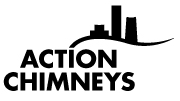Five main types of chimney problems.
“With winter fast approaching it’s worth giving some consideration to the condition of your chimney.”
Obstruction
Factors that restrict the ability of a chimney to produce or maintain a draft are classified as obstructions or blockages. Sometimes these obstructions are caused by physical factors such as motor deposits, birds nests or collapsed flues. In other cases the obstruction can be caused by poor chimney design such as insufficient height, nearby trees or negative air pressure due to the house being airtight.
Chimney blockages are dangerous and should be investigated as it can lead to toxic fumes to entering your home. If you are aware of any form of chimney obstruction then contact Action Chimneys and we will carry out a chimney inspection.
Creosote
Creosote is a highly flammable residue that builds inside a flue and results from the burning of fossil fuels such wood, coal or turf. There are generally three stages or phases associated with in the buildup of creosote inside a flue:
First degree
This involves a high percentage of soot and can be easily removed with a chimney brush. This occurs when there is good quality combustion of the fuel at high temperature. The fuel is dry and will burn well with lots of air for quality combustion.
Second Degree Creosote
Second degree creosote presents as a shiny black deposit of tar much thicker than the previous phase. Brushing can remove the deposit in the early stage if discovered and results when incoming air to the combustion area is restricted. The second stage is best described as the transition phase from first to third degree.
Third Degree Creosote
Third degree creosote presents as a thick black tar coating on the inside of the flue. The creosote buildup has reach a critical stage and is high combustible. It results when the flue temperatures are low and combustion incomplete. Brushing will not remove this residue which will continue to thicken often up to 25mm in thickness. This is found when any or all of these condition exist.
- Air control of stove is turned way down and fuel simply smoulder over a period of time. Traditionally this was referred to in Ireland as banking down the fire overnight.
- Un-insulated chimney or chimney that is exposed on an outside wall.
- Combustion of unseasoned wood.
- An oversized flue for the appliance.
- When the house is airtight and the appliance cannot draw sufficient air for proper combustion.
Brick / Block work issues
Chimney pointing in need of repair
A poorly maintained chimney can result with water penetrating the chimney system. Poorly jointed bricks or detective flashing will result with moisture entering the structure. Action Chimneys can re pointing and re flashing your chimneys, any preventative maintenance carried out will be far less costly than completely replacing a chimney stack at a later stage..
Cracks in flues
Chimney flues are subjected to a great deal of stress due to changes in temperature and from the deposits of residue of flammable substances. During a chimney fire the flues will expand and cracking will occur which can often go unnoticed by the homeowner. The chimney lining is what separates the fire from the combustible parts of the house so it is imperative that any damage is detected and immediately repaired.
Action Chimney use CCTV to inspect the lining of your chimney and will provide you with a detailed report of it’s condition.
Chimney Crown / Cap
Newly installed chimney crown
Your chimney stack is normally finished off with a chimney cap. If there is no cap fitted then it is referred to as a chimney crown. If the cap or crown is cracked then moisture will penetrate into the structure and into the chimney structure. Moisture will quickly impact not only on the chimney's structure but also ceilings and walls inside the home. This is of particular relevance during winter as any moisture retained in the masonry will expand during freezing conditions and cause serious damage to the structure.




